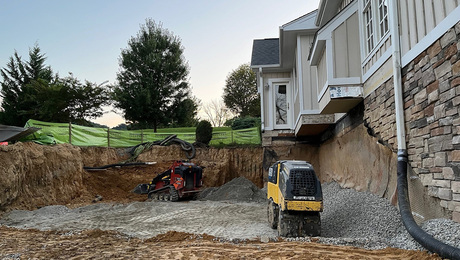Checking Your Construction Estimate
Having a fast, accurate way of checking your prospect's budget will save you time and money in the long run.

You’ve been there before. You’re discussing the budget of a potential project with a prospect, and you get that uneasy feeling in your gut that the prospect’s budget might not be enough for the project, but you’re a little unsure. You don’t want to miss out on closing the deal, but you also don’t want to lose money by making a commitment at such a preliminary stage of the sales process.
This is where having a fast, accurate way of checking your prospective customer’s budget will save you time and money in the long run.
Instead of pricing the work by calculating the cost of the materials, labor, subcontractors, and equipment, you should reverse- engineer the prospect’s budget for the time it takes to do the project.
Remember, you are not pricing the project at this stage of the sales process—you are simply verifying the budget. You will calculate the price of the project once you have determined the scope of work and all the details associated with it. But first you have to determine if the estimated budget is enough to cover the costs and provide you with the margin your business needs to make a profit.
Reverse-engineer the numbers
Let’s start with the margin, work our way back to the costs, and check the construction estimate. The example below comes from a conversation I had with one of my coaching clients.
The contractor asked the prospect for the budget of a potential kitchen remodel project. The prospect told the contractor her budget was $40,000 for this kitchen project and that she would provide the appliances, fixtures, and tile materials. The contractor’s initial gut reaction was that this budget was too small, but he wasn’t sure how to communicate what the budget should be. I told the contractor, “Let’s determine what we do know, and check this budget to see if it will work.”
We started with the following formula:
PRICE = COSTS × MARKUP FACTOR (see Pricing method #1 for more about this formula)
We know the budget, or price, is $40,000. And we know the markup factor for this construction business is 1.30, or a markup of 30%. (We previously determined the markup for this business by analyzing its profit and loss statements and developing a pricing strategy.)
Step 1: Start with what you know
We can now write the formula above like this:
$40,000 = COSTS × 1.3
Step 2: Solve for COSTS
If you remember the rules from algebra class, then we can solve for COSTS by writ- ing the formula like this:
COSTS = $40,000 ÷ 1.3
Now we can determine COSTS.
COSTS = $30,769.23
The difference between the price of $40,000 and $30,769.23 is your GROSS PROFIT. This means that if your costs for this project equal $30,769.23 and you sell these COSTS for $40,000, you will have this gross profit:
GROSS PROFIT = PRICE − COSTS = $40,000 − $30,769.23 = $9,230.77
And your margin is:
MARGIN = GROSS PROFIT ÷ PRICe × 100 = $9,230.77 ÷ $40,000 x 100 = 23%
When you start with your price and divide by your markup factor, you are essentially taking your profit first and determining if the remaining budget is enough to buy the COSTS of the project. (This method of reverse engineering your business is the subject of my book, Profit First
for Contractors.)
Step 3: Estimate COSTS of Materials and Subs
Now that we know the budget for the COSTS, we can start to subtract the estimated costs of the subcontractors and materials.
At this point in the process, you do not need to calculate the cost of the subcontractors and materials—you just need to estimate them. Remember, this is not a quote. This is an estimate. An estimate is a guess based on your experience. That’s it.
Here’s a table showing the estimated costs the contractor came up with based on his experience and an initial conversation with the prospect:
Step 4: Estimate the labor
I asked the contractor, “How long will it take to complete the project?”
He said, “Probably about four weeks over- all for a couple of guys.”
I replied, “So would you estimate it would take two guys two weeks if they could work straight through?”
He answered, “Yeah, that sounds about right. It’s two weeks of work for two guys over about four weeks time.”
I said, “Great. That’s 160 man hours— two guys working 40 hours per week for two weeks.”
Now we can estimate the labor costs for this project.
The wage for this level of production work is $35 per hour for this business.
Labor costs = $35 per hour × 160-man hours = $5,600
Step 5: Determine the estimated budget price
In this example, the total estimated costs without labor of $32,450 exceeds the bud- get costs of $30,769.23. Therefore, we know that the $40,000 budget is not realistic.
If the total estimated costs without labor were less than the budget costs, then you would divide the total estimated costs with- out labor by the hourly wage to determine the number of man hours available to do the work.
This is not the case for this project. We need to determine the correct budget based on what we know.
We estimated the labor cost at $5,600. We know the estimated cost without labor is $32,450. We also know that because this customer is already trying to “save money” by buying some materials and fixtures, this will cause additional delays and coordina- tion. The contractor decided to add a 10% difficulty factor to the estimated costs of the job to account for this. Therefore, the total estimated costs are:
TOTAL ESTIMATED COSTS = ($5,600 + $32,450) × 1.1 difficulty factor = $41,855
This is the cost of the project. This is not the price. We need to add the markup for this project.
The budget price for this project is:
PRICE = $41,855 × 1.3 = $54,500
Remember, this does not include the appliances, fixtures, and tile. This budget is only for the items listed above, and much of that was just a guess. There will be more when the contractor digs into the details.
Getting real with your customers
Based on this information, which took about five minutes to produce, the contrac- tor now knows what to tell the prospect. The $40,000 budget is not enough for the work she wants done. The budget for this project should be about $55,000, and she should probably plan on spending about $70,000 once the appliances, fixtures, and tile are included.
The prospect’s budget does not fit the estimate. This contractor will either sell the prospect on the appropriate budget, or walk away. There is no need to waste any more time running numbers. He knows everything he needs to know.
Calculate profitability
You cannot guess your way to profitability. You must calculate it. Once you have established a budget with your potential customer, then you need to ensure that your estimate is accurate for the preliminary scope of work.
Reverse-engineering your costs from the budget is a fast, accurate way to determine what your estimate should be. Once you have checked your construction estimate with realistic numbers and determined that the prospect has the budget, then you can move forward with developing the scope of work and preparing a proposal.
But preparing a proposal for a project is work, and professionals get paid to do work. Charge your prospects for a proposal. That’s when they become customers—when they actually buy something from you.
Follow me on YouTube, Instagram @shawnvandyke, LinkedIn, Facebook, or shawnvandyke.com to learn more about how to streamline your construction business. My new book, Profit First for Contractors, will be released later this year. Follow the @ProfitFirstContractor account on Instagram for more information about the release of the book.





























View Comments
Amen. Very good way to save yourself the hassle of chasing a job that will go nowhere.
Really very happy to say, your post is very interesting to read. You’re doing a great job. Keep it up.
Thanks.
https://www.prithu.in/